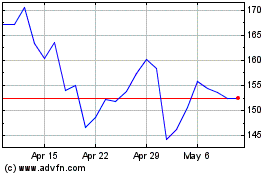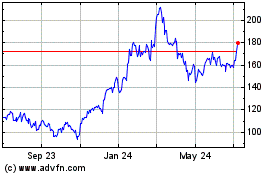The AMD EPYC™ Server Ecosystem Grows with New HCI Solutions From Nutanix and Other Partners Supporting “Work from Anywher...
October 14 2020 - 9:00AM

AMD (NASDAQ: AMD) today announced the continued expansion of the
AMD EPYC™ processor ecosystem for virtualized environments and
hyperconverged infrastructure (HCI) with Lenovo announcing the
ThinkAgile HX, the latest solution based on AMD EPYC processors and
Nutanix’s hybrid cloud infrastructure solution. This new solution
expands the ecosystem of AMD EPYC based cloud and virtualized
solutions.
As customers want more value for their data center budget, IT
departments are moving to HCI to modernize and transform their
enterprise data center. This creates a high performing and
efficient data center that is easier to manage for the
quick-changing needs of businesses. By choosing AMD EPYC processors
and Nutanix hybrid and multicloud solutions, customers can
accelerate workloads like digital workspaces including VDI with
fantastic performance, advanced security features, and broad
ecosystem support from major ISVs and OEM partners.
“IT leaders are faced with a difficult and evolving situation
right now. As more employees are in a ‘work from anywhere’
situation, they have to rethink their data center operations and
move them to a more digital and modern environment that can provide
the security, performance and agility needed to support their
business,” said Dan McNamara, senior vice president and general
manager, Server Business Unit, AMD. “A virtualized or HCI
environment powered by AMD EPYC processors gives these data center
operators and IT administrators the power to provide a
high-performance virtualized environment with leading-edge security
features, across a wide variety of OEM platforms and software
solutions. This will not only help them in this ‘work from
anywhere’ environment but also enable them to contribute to their
company’s business goals.”
“As Nutanix evolves from delivering industry-leading HCI
software to hybrid cloud infrastructure we look to provide our
customers with the best software and hardware solutions to help
modernize their data centers, as part of their hybrid and
multicloud strategies,” said Tarkan Maner, Chief Commercial Officer
at Nutanix. “Nutanix software, along with OEM platforms and AMD
EPYC processors, deliver the performance, flexibility, and choice
our customers need to support databases, analytics, digital
workspaces and other business critical applications. We’re excited
to continue this collaboration with AMD and help our customers
modernize their data centers.”
The Growing AMD EPYC HCI EcosystemAMD EPYC™
processors have become a leading choice to drive innovation of
virtualization and HCI solutions due to its accelerated
performance, class leading memory capabilities¹, and advanced
security features. These solutions using AMD EPYC processors are
now widely available, customers have a choice of solutions when
modernizing their data centers.
“In our business we are heavily focused on HCI solutions and
software defined storage and the AMD EPYC processors have
dramatically expanded the horizon of what we can build to support
HCI and software defined storage,” said Aleksandr Ragel, co-founder
and Managing Partner, Diaway. “This is why we chose the AMD EPYC
processor to power the DIAWAY EDGEBOX™, a turnkey solution that’s
ideal for large-scale software-defined storage, HCI and diverse
software stacks. We’ve seen customers use the EPYC powered EDGEBOX
for storage intensive workloads, and even pure HCI environments,
where the EPYC processor does the compute and the EDGEBOX runs the
management layer for a private cloud. We are excited to continue
our work with AMD to deliver fantastic HCI solutions based on
EPYC.”
“AMD EPYC processors have enabled us to deploy high-density
hyperconverged infrastructure servers with unprecedented
flexibility,” said Bart Willems, technology director, ATIPA
Technologies. “The AMD EPYC processor’s high core counts and
support of PCIe 4 were instrumental in allowing us to pack more
performance for more virtual machines with faster network access
and lower storage latency in as little data center space as
possible.”
AMD has worked closely with its OEM and software provider
partners to offer solutions with leading performance, scalability,
and total cost of ownership (TCO). These HCI solutions include:
- Dell Technologies○ Dell EMC
XC Core XC6515 – The
Dell EMC XC Core XC6515 is an AMD EPYC processor based XC appliance
from Dell Technologies. Fully qualified by Nutanix, the single
socket 1U chassis provides up to 64 high performance cores, PCIe®
4, and performance for VDI, database, and ROBO
workloads.○ Dell EMC Solutions for Azure Stack
HCI – The AX-6515 solution is powered by 2nd Gen AMD EPYC
processors and provides advantages for leveraging Microsoft
virtualization environments.
- HPE○ HPE ProLiant DX325 &
DX385 optimized with Nutanix software – Using AMD EPYC
processors based on HPE ProLiant servers, which are the world’s
most industry-standard servers, are an advanced choice for
customers selecting Nutanix software with HPE.○ HPE
ProLiant DL325 and DL385 Gen10 servers with HPE Nimble Storage
dHCI – Using 2nd Gen AMD EPYC processors, these servers
are architected for VDI users, business-critical applications, and
mixed workloads with unpredictable
growth.○ HPE SimpliVity
325 Gen10 HCI – An industry-leading HCI solution
for the enterprise edge based on the HPE DL325 Gen 10 server using
the HPE SimpliVity HCI software and powered by 2nd Gen AMD EPYC
processors. The solution offers customers a small 1U footprint,
2-node high availability, that lowers TCO with industry-leading
VDI-density.
- Lenovo Data Center Group○ Lenovo
ThinkAgile HX – in collaboration with Nutanix and AMD,
Lenovo recently announced the new Lenovo ThinkAgile HX HCI
solutions powered by AMD EPYC processors, enabling customers to run
virtual desktop workloads at a higher density, and maintain
consistent performance (in the same 1U form factor), with up to 50%
fewer servers².○ The Lenovo ThinkAgile HX 3000 Series
appliance – Featuring AMD EPYC processors, it is available
in a rack-dense 1U 1-node form-factor and supports high memory and
core density, making it a good solution for virtual desktop
infrastructure and general virtualization workloads.
As HCI continues to provide efficiencies and agility for
demanding IT requirements driving the customers’ cloud experience,
AMD has been working closely with our ecosystem partners to deliver
fully tested and validated solutions. With the ongoing success with
industry partners like Dell Technologies, HPE, Lenovo, Microsoft
and Nutanix, AMD is committed to continue providing the best
possible solutions for partners and customers.
Supporting Resources
- Learn more about AMD EPYC processors for HCI
- Read more about the AMD growth in HCI and virtualization
- Learn more about AMD Infinity Guard
- Check out a recent HCI whitepaper from Insight64 about HCI
- Follow AMD on Twitter
About AMDFor more than 50 years AMD has driven
innovation in high-performance computing, graphics and
visualization technologies ― the building blocks for gaming,
immersive platforms and the datacenter. Hundreds of millions of
consumers, leading Fortune 500 businesses and cutting-edge
scientific research facilities around the world rely on AMD
technology daily to improve how they live, work and play. AMD
employees around the world are focused on building great products
that push the boundaries of what is possible. For more information
about how AMD is enabling today and inspiring tomorrow, visit the
AMD (NASDAQ: AMD) website, blog, Facebook and
Twitter pages.
___________________________________________________
¹ EPYC™ 7002 series has 8 memory channels, supporting 3200 MHz
DIMMs yielding 204.8 GB/s of bandwidth vs. the same class of Intel
Scalable Gen 2 processors with only 6 memory channels and
supporting 2933 MHz DIMMs yielding 140.8 GB/s of bandwidth. 204.8 /
140.8 = 1.454545 - 1.0 = .45 or 45% more. AMD EPYC has 45% more
bandwidth. Class based on industry-standard pin-based (LGA) X86
processors. ROM-11² ThinkAgile HX Intel platform can have a maximum
of 56C in a 2S platform vs. 128C in ThinkAgile HX AMD based
platform. Higher VDI density claim is based on extrapolation of
performance results for virtual desktops on ThinkAgile HX and
ThinkSystem with Citrix. A 2S Intel ThinkAgile HX platform with 28C
CPU would support approximately 260 Knowledge workers per node when
system is CPU bound based on (https://lenovopress.com/lp0665.pdf
Table 7 Section 4.6.2). A 2S AMD ThinkAgile HX platform with 64C
CPU would support 500 Knowledge workers per node based on -
https://lenovopress.com/lp0664.pdf Table 11 Section 4.3.2. This
gives us approximately 92% improvement in Citrix Knowledge. AMD has
not independently verified this data.
Links to third party sites are provided for convenience and
unless explicitly stated, AMD is not responsible for the contents
of such linked sites and no endorsement is implied.
AMD, the AMD logo, EPYC, and combinations thereof are trademarks
of Advanced Micro Devices, Inc.
Contacts:
Aaron Grabein
AMD Communications
+1 512-602-8950
Aaron.Grabein@amd.com
Laura Graves
AMD Investor Relations
+1 408-749-5467
Laura.Graves@amd.com
Advanced Micro Devices (NASDAQ:AMD)
Historical Stock Chart
From Mar 2024 to Apr 2024

Advanced Micro Devices (NASDAQ:AMD)
Historical Stock Chart
From Apr 2023 to Apr 2024
